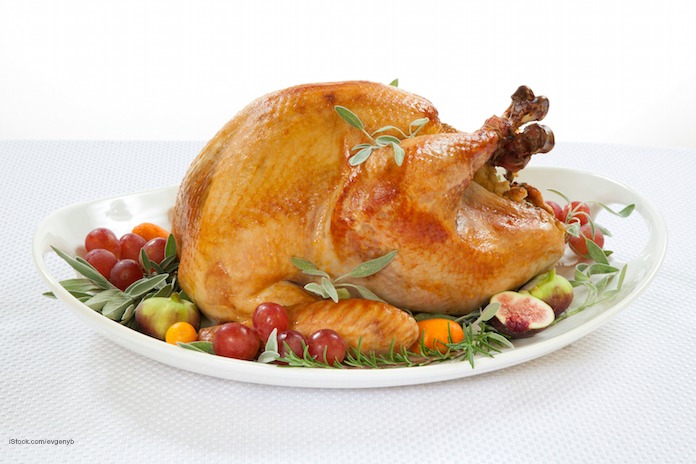It’s almost Thanksgiving! Prepare your holiday turkey safely with tips from the Centers for Disease Control and Prevention (CDC). Since turkey can be contaminated with Salmonella bacteria, it must be handled carefully.

First of all, store the turkey properly. It should be stored in the freezer until you are ready to thaw it. Do not store a turkey in a car trunk, in snow, or on the back porch. At this point it’s too late to properly thaw a large frozen turkey in the fridge, but you can cook it from the frozen state. It takes 24 hours of thawing in the refrigerator for each four to five pounds of turkey.
Never ever thaw a turkey or any meat on the counter. The meat will remain in the danger zone of 40°F to 140°F too long, and bacteria will multiply. At room temperature, bacterial counts can double every 20 minutes. Then, even if you cook the turkey thoroughly, the bacteria could have produced toxins that are not destroyed by heat.
You can thaw the turkey in cold water. Put it into a leak proof plastic bag and put it in the sink. Cover it completely with cold tap water, and change the water every 30 minutes. Allow 30 minutes of thawing per pound. You must then cook the turkey immediately.
You can also thaw the turkey in the microwave oven. Follow the manufacturer’s instructions and, again, cook the turkey immediately.
Never rinse a turkey or chicken or any raw meat before cooking. The USDA has recommended against this practice since 2005. Unfortunately, a 2020 survey found that 79% of respondents wash or rinse their turkey before cooking. This can aerosolize bacteria and spread it up to three feet from the sink faucet, contaminating food, surfaces, and you.
Raw turkey and its juices can contaminate anything they come into contact with. Use a separate cutting board for raw turkey. Never put cooked food or fresh produce on a plate or any surface that held raw turkey. And wash cutting boards, dishes, utensils, and countertops, along with your hands, with soapy water after working with raw turkey.
When it comes to stuffing, or dressing, it’s safest to cook it outside of the turkey. You can use a slow cooker or put the stuffing into a casserole dish and bake it. Make sure that the stuffing reaches 165°F whether you cook it inside the turkey or in a casserole. If you did stuff the turkey, after you take it out of the oven wait for 20 minutes before removing the stuffing so it can cook a bit longer through carry over cooking.
Speaking of the temperature, always cook all poultry to a final internal temperature of 165°F. Use a reliable food thermometer to measure the temperature in the center of the stuffing and in the thickest part of the breast, wing, and thigh. Make sure the thermometer probe is not touching bone because the reading will be inaccurate.
And finally, since leftovers are an important part of the holiday, refrigerate the turkey and stuffing and other perishable dishes within two hours of cooking. Cooked turkey and dishes made with turkey can be stored in the fridge for three to four days or they can be frozen.
Here’s a special warning: The bacteria Clostridium perfringens can grow in large quantities of cooked foods; it is the second most common cause of bacterial food poisoning. Outbreaks linked to this pathogen occur most often in November and December, and most of these outbreaks raw linked to turkey, gravy, and roast beef. Divide large quantities of food into smaller portions before refrigerating them so the center cools quickly. And properly reheat all leftovers to at least 165°F before serving.
Now that you know how to safely prepare your holiday turkey, have a wonderful Thanksgiving!




